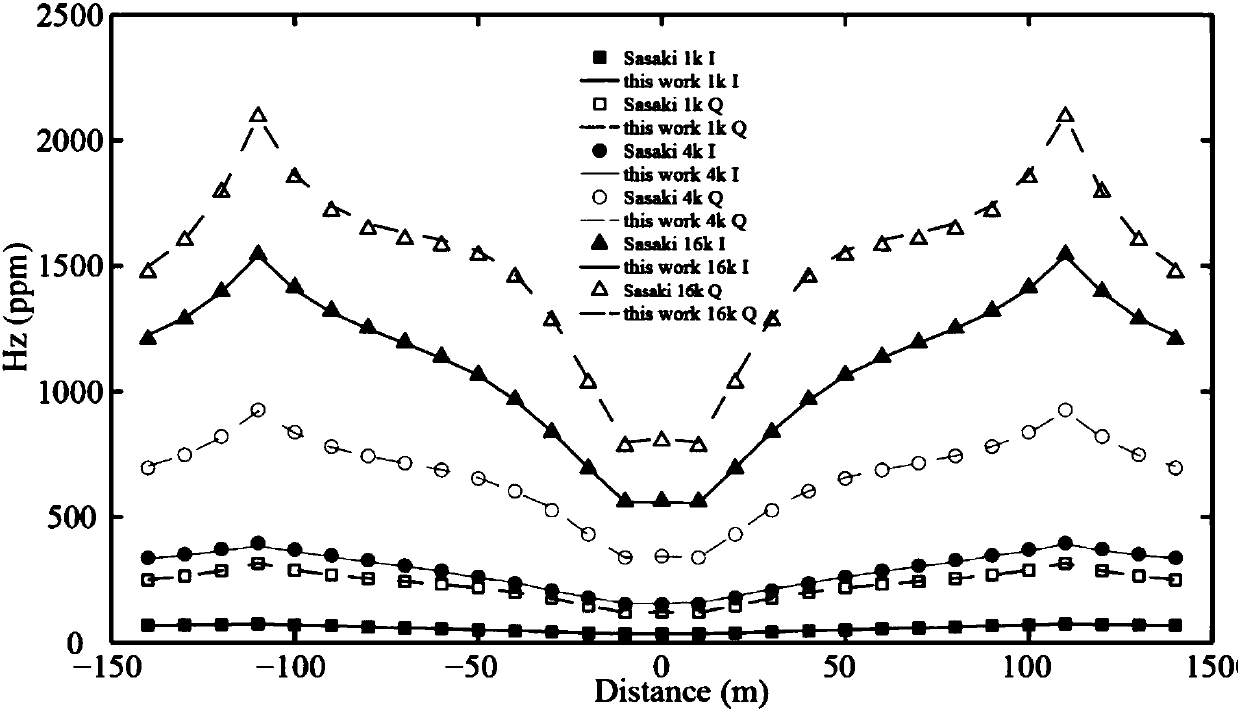A Frequency-Domain Airborne Electromagnetic Method for 2.5D Strip Terrain Inversion
An airborne electromagnetic and frequency domain technology, applied in the field of airborne geophysical prospecting, to avoid false solutions, eliminate the influence of terrain, and overcome the effect of step effect
- Summary
- Abstract
- Description
- Claims
- Application Information
AI Technical Summary
Problems solved by technology
Method used
Image
Examples
Embodiment 1
[0084] A frequency-domain airborne electromagnetic method 2.5-dimensional belt terrain inversion method, comprising the following steps, that is, the inversion process is as follows:
[0085] 1) Define the objective function, set the number of iterations to i=0, the fitting accuracy and the maximum number of iterations, and input the initial model and inversion data;
[0086] 2) Carry out forward calculation, solve the forward equation KF=b to obtain the secondary magnetic field H x and H z ;
[0087] 3) Calculate the fitting error, if it reaches the set accuracy or the maximum number of iterations, exit the calculation, otherwise continue;
[0088] 4) Calculate the Jacobian matrix with quasi-forward modeling to obtain the model update step size;
[0089] 5) Update model parameters, m k+1 = m k +Δm.
[0090] In step 1), the defined objective function is shown in formula 1,
[0091]
[0092] In formula 1, d is the data vector obtained from forward modeling, d obs is ...
Embodiment 2
[0144] The forward modeling calculation carried out in step 2), the process of forward modeling accuracy verification is as follows:
[0145] In order to verify the correctness of this algorithm, the same two-dimensional trapezoidal mountain model as Sasaki (Yutaka et al., 2003) is used, as shown in Figure (2). The top and bottom of the trapezoidal mountain are 20m and 220m respectively, the distance from the top to the bottom of the mountain is 50m, the slope is 26.5°, and the resistivity of the medium is 100ohm-m. The simulation area is divided into 41×41×41 grids in the x, y and z directions, the grid size in the middle area is 10m×10m×10m, and the maximum grid size at the boundary is 1280m×1280m×1280m. The horizontal coplanar device (HCP) is used for calculation, the distance between the transmitting and receiving coils is 30m from the ground, and the transmitting and receiving distance is 10m, and three frequencies of 1k Hz, 4k Hz and 16kHz are used for calculation. The ...
Embodiment 3
[0149] Design a low-resistance combined model of hills, as shown in Figure (9). There are two low-resistance anomalous bodies buried in the uniform half-space, the resistivity of the anomalous body is 10ohm-m, and the background resistivity is 300ohm-m. The top of the mountain is 20m wide,
[0150] The distance from the foot of the mountain is 50m, and the slope is 26.6°. We simulate undulating terrain by varying the z-coordinate of the mesh. The horizontal coplanar (HCP) device was used for forward modeling, and four frequencies were used, namely 1000Hz, 2700Hz, 7400Hz and 20000Hz. The transmitting and receiving distance of the coil is 8m, the height from the ground is 20m, the point distance is 10m, and there are 51 measuring points in total. The simulation area is divided into 69×34×29 grids, the grid size of the middle area is 10m×10m×10m, and the maximum grid size of the expanded border area is 1280m×1280m×1280m. The forward modeling results of the horizontal coplanar...
PUM
 Login to View More
Login to View More Abstract
Description
Claims
Application Information
 Login to View More
Login to View More - R&D
- Intellectual Property
- Life Sciences
- Materials
- Tech Scout
- Unparalleled Data Quality
- Higher Quality Content
- 60% Fewer Hallucinations
Browse by: Latest US Patents, China's latest patents, Technical Efficacy Thesaurus, Application Domain, Technology Topic, Popular Technical Reports.
© 2025 PatSnap. All rights reserved.Legal|Privacy policy|Modern Slavery Act Transparency Statement|Sitemap|About US| Contact US: help@patsnap.com



